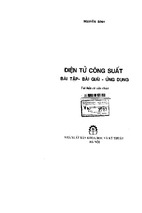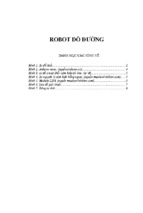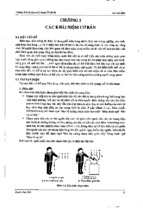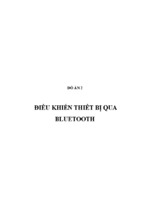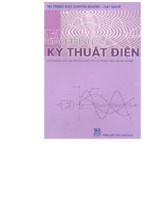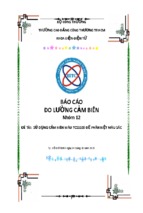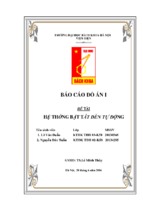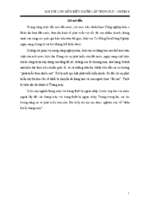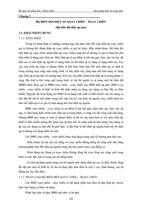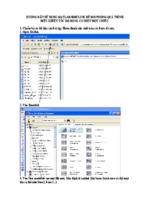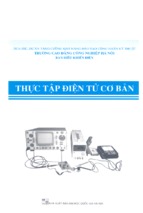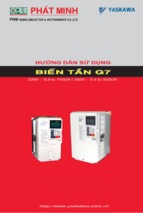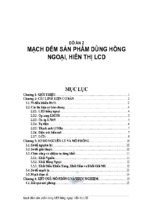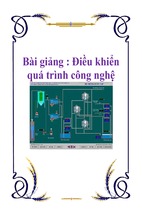PIC Robotics
This page intentionally left blank.
PIC Robotics
A Beginner’s Guide to
Robotics Projects
Using the PICmicro
John Iovine
McGrawHill
New York
Chicago San Francisco Lisbon London Madrid
Mexico City Milan New Delhi San Juan Seoul
Singapore Sydney Toronto
Copyright © 2004 by The McGrawHill Companies, Inc. All rights reserved.
Manufactured in the United States of America. Except as permitted under the United
States Copyright Act of 1976, no part of this publication may be reproduced or dis
tributed in any form or by any means, or stored in a database or retrieval system,
without the prior written permission of the publisher.
0071394559
The material in this eBook also appears in the print version of this title:
0071373241.
All trademarks are trademarks of their respective owners. Rather than put a trade
mark symbol after every occurrence of a trademarked name, we use names in an edi
torial fashion only, and to the benefit of the trademark owner, with no intention of
infringement of the trademark. Where such designations appear in this book, they
have been printed with initial caps.
McGrawHill eBooks are available at special quantity discounts to use as premiums
and sales promotions, or for use in corporate training programs. For more informa
tion, please contact George Hoare, Special Sales, at george_hoare@mcgrawhill.com or
(212) 9044069.
TERMS OF USE
This is a copyrighted work and The McGrawHill Companies, Inc. (“McGrawHill”)
and its licensors reserve all rights in and to the work. Use of this work is subject to
these terms. Except as permitted under the Copyright Act of 1976 and the right to
store and retrieve one copy of the work, you may not decompile, disassemble, reverse
engineer, reproduce, modify, create derivative works based upon, transmit, distribute,
disseminate, sell, publish or sublicense the work or any part of it without McGraw
Hill’s prior consent. You may use the work for your own noncommercial and personal
use; any other use of the work is strictly prohibited. Your right to use the work may
be terminated if you fail to comply with these terms.
THE WORK IS PROVIDED “AS IS.” McGRAWHILL AND ITS LICENSORS MAKE
NO GUARANTEES OR WARRANTIES AS TO THE ACCURACY, ADEQUACY OR
COMPLETENESS OF OR RESULTS TO BE OBTAINED FROM USING THE
WORK, INCLUDING ANY INFORMATION THAT CAN BE ACCESSED THROUGH
THE WORK VIA HYPERLINK OR OTHERWISE, AND EXPRESSLY DISCLAIM
ANY WARRANTY, EXPRESS OR IMPLIED, INCLUDING BUT NOT LIMITED TO
IMPLIED WARRANTIES OF MERCHANTABILITY OR FITNESS FOR A PARTIC
ULAR PURPOSE. McGrawHill and its licensors do not warrant or guarantee that
the functions contained in the work will meet your requirements or that its operation
will be uninterrupted or error free. Neither McGrawHill nor its licensors shall be
liable to you or anyone else for any inaccuracy, error or omission, regardless of cause,
in the work or for any damages resulting therefrom. McGrawHill has no responsi
bility for the content of any information accessed through the work. Under no cir
cumstances shall McGrawHill and/or its licensors be liable for any indirect,
incidental, special, punitive, consequential or similar damages that result from the
use of or inability to use the work, even if any of them has been advised of the possi
bility of such damages. This limitation of liability shall apply to any claim or cause
whatsoever whether such claim or cause arises in contract, tort or otherwise.
DOI: 10.1036/0071394559
For more information about this title, click here.
Contents
Preface
xi
Chapter 1. Robot Intelligence
What Is a Microcontroller?
Why Use a Microcontroller?
Designer Computers—So Many Microcontrollers
The Compiler
PIC Programming Overview
Software and Hardware
PicBasic and PicBasic Pro Compilers
EPIC Programmer
Firmware
Consumables
16F84 PIC Microcontroller
Step 1: Writing Code (the Basic Program)
Step 2: Using the Compiler
Step 3: Installing the Firmware, or Programming the PIC Chip
Ready, Steady, Go
Parts List
Chapter 2. Installing the Compiler
1
1
1
2
2
2
2
3
4
5
5
5
6
7
7
8
8
11
Installing the PicBasic Compiler Software
Installing the PicBasic Pro Compiler
11
12
Chapter 3. Installing the EPIC Software
19
Installing the EPIC Software in Windows
Installing the EPIC Software, DOS Version
Supplemental—Applications Directory
19
22
22
Chapter 4. CodeDesigner
23
CodeDesigner Features
Software Installation
23
25
v
vi
Contents
Setting CodeDesigner Options
First Program
The EPIC Programming Board Software
Parts List
Chapter 5. Using DOS to Code, Compile, and Program
25
31
33
35
37
Compile
Programming the PIC Chip
The EPIC Programming Board Software
Using EPIC DOS Version
Continuing with the wink.bas Program
39
43
44
45
45
Chapter 6. Testing the PIC Microcontroller
49
The PIC Microntroller
The Solderless Breadboard
Three Schematics, One Circuit
Wink
Troubleshooting the Circuit
PIC Experimenter’s Board and LCD Display
PIC Experimenter’s Board
Use
Simple Experiment
Builtin LCD
Using the LCD: PicBasic and PicBasic Pro Examples
Introduction to Binary and the PIC Microcontroller
Using TRIS and Port Registers
Accessing the Ports for Output
Counting Program
Counting in Binary by 1
Input
The button Command
A button Example
peek
peek and PicBasic Pro
Basic Input and Output Commands
Servomotors
Parts List
Chapter 7. Intelligence
Approaches to Building Intelligence
Where’s the Intelligence?
Layered Behavioral Responses
BehaviorBased Robotics
Chapter 8. Walter’s Turtle
BehaviorBased Robotics
William Grey Walter—Robotics Pioneer
Four Modes of Operation
49
49
50
53
54
54
56
56
58
60
63
65
68
70
71
71
72
72
74
75
76
77
78
79
83
83
85
85
86
87
87
87
88
Contents
Observed Behavior
Building a Walter Tortoise
Drive and Steering Motors
Modifying the HS425BB Servomotor
Sheet Metal Fabrication
Shell
Finding the Center of Gravity
Attaching Bumper to Robot Base
Bumper Switch
Mounting the Steering Servomotor
Photoresistor
Trimming the Sensor Array
Schematic
Program
Adding Sleep Mode
Power
Behavior
Fudge Factor
Light Intensity
Handedness
Parts List
Chapter 9. Braitenberg Vehicles
Neural I/O Relationships
Vehicles
Building Vehicles
Back Wheels
Front Wheels
CdS Photoresistor Cells
Trimming the Sensor Array
PIC 16F84 Microcontroller
Testing
Second Braitenberg Vehicle (Avoidance Behavior)
Parts List
Chapter 10. Hexapod Walker
Imitation of Life
Six Legs—Tripod Gait
ThreeServomotor Walker Robot
Function
Moving Forward
Moving Backward
Turning Left
Turning Right
Construction
Mounting the Servomotors
Leg Positioning
Linkage
vii
88
89
90
91
97
99
100
101
104
107
109
112
114
115
121
121
121
121
121
123
123
125
126
126
128
129
131
133
137
139
139
141
141
143
143
143
144
144
145
146
147
148
148
151
152
154
viii
Contents
Center (Tilt) Servomotor
Sensors
Electronics
Microcontroller Program
Parts List
Chapter 11. Speech Recognition
Applications
Software Approach
Learning to Listen
SpeakerDependent and SpeakerIndependent Recognition
Recognition Style
Speech Recognition Circuit
Circuit Construction
Keypad
To Train
Testing Recognition
Error Codes
Clearing the Trained Word Memory
Independent Recognition System
Voice Security System
Speech Interface Control Circuit
How the Circuit Works
PIC 16F84 Microcontroller Program
Active High Output
SPDT Relay Output
Circuit Construction
Programming the Speech Recognition Circuit: Training, Testing, and Retraining
SRI02 and SRI03 Interfaces
Robot Control
Parts List
Chapter 12. Robotic Arm
Servomotor Building Blocks for Robotics
Basic Servomotor Bracket Assembly
Assembling MultipleServomotor Assemblies
Building a FiveServomotor Robotic Arm
Servomotors
Servomotor Controllers
Simple Servomotor Controller
Four and FiveServomotor Controllers
Increasing the Lifting Capacity of the Robotic Arm
Adding a Robotic Arm Base
Parts List
Chapter 13. Bipedal Walker Robot
A Question of Balance?
A Little Feedback
Servomotors
154
155
158
159
164
165
167
167
167
167
168
168
168
169
169
172
172
172
172
173
173
174
176
177
177
177
177
180
180
181
185
185
186
189
192
197
199
200
204
215
216
223
225
226
227
227
Contents
Servomotor Brackets
Footpads
Assembly
Schematic
Program
Subroutines M1, M2, and M3
Going Further
Turning Right and Left
Parts List
ix
228
228
230
231
233
234
241
242
242
Chapter 14. Color Robotic Vision System
243
CMU Camera
Serial Communication
VB Application Program
Interfacing the CMU Camera to a Robot
PIC 16F84 Runs at 16 MHz
Program 1
Program 2
Incandescent or Fluorescent Lighting
Servomotors for Robot
Program 3
Robot Construction
Running the Program
Going Further
Parts List
244
245
248
250
251
251
254
254
259
261
264
266
267
267
Suppliers 269
Index 271
This page intentionally left blank.
Preface
This is a project book on building small robots. Each robot utilizes the PICmicro
series of microcontrollers from Microchip Technologies Inc. for intelligence, nav
igation, motor control, and sensory readings. By changing the microcontroller
programming and sensory electronics we can create a zoo of robots that includes
photovores, behaviorbased (neural) robots, hexapod and bipedal walkers, and
artificial vision systems that can track and follow objects.
Each robot project has something to teach.
John Iovine
xi
This page intentionally left blank.
Chapter
1
Robot Intelligence
The robotic projects outlined in this book make extensive use of the PIC series
of microcontroller from Microchip Technology Inc. In addition to its ability to
run programs, the microcontroller has input and output lines (pins) that are
used to control motor drive systems, read sensors, and communicate. We
demand a lot from our microcontroller(s), so it’s important to have a good idea
of what a microcontroller is right from the start.
What Is a Microcontroller?
A microcontroller is essentially an inexpensive singlechip computer. Single
chip means the entire computer system lies within the confines of a sliver of
silicon encapsulated inside the plastic housing of an integrated circuit. The
microcontroller has features similar to those of a standard personal computer.
The microcontroller contains a CPU (central processing unit), RAM (random
access memory), ROM (readonly memory), I/O (input/output) lines, serial and
parallel ports, timers, and sometimes other builtin peripherals such as ana
logtodigital (A/D) and digitaltoanalog (D/A) converters. The key feature,
however, is the microcontroller’s capability of uploading, storing, and running
a program.
Why Use a Microcontroller?
Being inexpensive singlechip computers, microcontrollers are easy to embed
into larger electronic circuit designs. Their ability to store and run unique pro
grams makes them extremely versatile. For instance, one can program a
microcontroller to make decisions and perform functions based on situations
(I/O line logic) and events. The math and logic functions allow the microcon
troller to mimic sophisticated logic and electronic circuits.
1
Copyright © 2004 The McGrawHill Companies. Click here for terms of use.
2
Chapter One
Programs can also make the microcontroller behave as a neural network
and/or a fuzzy logic controller. Microcontrollers are incorporated in consumer
electronics and are responsible for the “intelligence” in these smart electronic
devices.
Designer Computers—So Many Microcontrollers
There are a large variety of microcontrollers on the market. We will use the
versatile microcontroller chips called PIC chips (or PICmicro chips) from
Microchip Technology Inc.
The Compiler
There are a number of compilers on the market that allow users to write pro
grams (code) in different highlevel languages. Highlevel language frees the
programmer from wrestling with and controlling the microcontroller’s regis
ters when writing code and accessing the different aspects of the microcon
troller’s features and memory.
The highlevel language I use is a derivative of the Basic language. It is
called PicBasic. (The PicBasic and PicBasic Pro compilers used to write
PicBasic programs are products and trademarks of microEngineering Labs,
Inc.) PicBasic is similar to the PBasic language used in programming the
Basic Stamp series. Programming microcontrollers directly using the
PicBasic (or PicBasic Pro) compiler offer two major advantages over the Basic
Stamp series of microcontrollers which use external serial EEPROM for
memory storage, faster program execution speed (20 to 100fold increase),
and reduced cost.
PIC Programming Overview
Programming PIC microcontrollers is a simple threestep process: Write the
code, compile the code, and upload the code into a microcontroller. Following
is an overview of the process; stepbystep instructions will be provided in the
following chapters.
Software and Hardware
You will need two items to begin programming and building microcontroller
based projects and robotics. First is the compiler, either the PicBasic Pro or
PicBasic compiler (see Fig. 1.1). The PicBasic Pro compiler from
microEngineering Labs, Inc. has a suggested retail price of $249.95. The
PicBasic compiler from microEngineering Labs, Inc. has a suggested retail
price of $99.95. In addition to a compiler you need the EPIC programming
board and software; this package sells for $59.95 (see Fig. 1.2). (EPIC is a
product and trademark of microEngineering Labs, Inc.)
Robot Intelligence
3
Figure 1.1 PicBasic Pro and PicBasic software packages and manuals.
Figure 1.2 EPIC Programmer software and hardware.
PicBasic and PicBasic Pro Compilers
The PicBasic and PicBasic Pro compilers both function in the same way. Saved
program code (text file) is run through a compiler (either the PicBasic or
PicBasic Pro compiler). The compiler reads through the text file and creates
(compiles) an equivalent machine code instruction listing (.hex file) of the
program. The machine code (.hex file) is a list of hexadecimal numbers that
represent the PicBasic program. The list of hexadecimal numbers (.hex file)
is uploaded (programmed) into the microcontroller. When the microcontroller
4
Chapter One
is started, its CPU will run through the programmed list of hexadecimal num
bers, running the PicBasic program. Uploading the machine code (.hex file)
into the microcontroller is the job of the EPIC Programmer board and soft
ware, which we will look at shortly.
The PicBasic Pro compiler is considerably more expensive than the standard
PicBasic compiler. The Pro version offers an enhanced and richer basic command
syntax than is available in the PicBasic compiler package. A few of the addition
al commands that can be found in the Pro version allow the use of interrupts,
direct control of LCD modules, DTMF out, and X10 commands, to name a few.
While the PicBasic Pro is a more sophisticated package, the compiler does
not handle two of my favorite Basic commands, peek and poke. Although the
commands are listed as “functional” in the Pro manual, it is emphasized that
“PEEK and POKE should never be used in a PicBasic Pro program.” There are
workarounds to using the peek and poke commands in the Pro version that
will be covered when needed later on.
In the balance of this book, at times I will refer to both the PicBasic and
PicBasic Pro compilers simply as the compiler(s). This saves me from continu
ally writing PicBasic and PicBasic Pro compiler throughout the book. When a
distinction becomes necessary, I will specify the individual compiler.
The compiler program may be run manually in DOS or in an “MSDOS
Prompt” window. A third option, and one you will probably use, is to run the
compiler within a Windows program called CodeDesigner. CodeDesigner is
discussed later in this chapter and fully in Chap. 4.
The minimum system requirement for the compiler is an XTclass personal
computer (PC) running DOS 3.3 or higher. The compiler can compile programs
for a large variety of PIC microcontrollers.
EPIC Programmer
The second item needed is the EPIC Programmer, also made by
microEngineering Labs, Inc. The EPIC Programmer consists of software
(EPIC) and a programming carrier board (hardware). The EPIC software
package has two executable files, one for DOS and another version of the soft
ware for Windows.
It is the EPIC hardware and software that takes the compiled .hex file gen
erated by the compiler and uploads it into the microcontroller, where it may be
run. The EPIC Programmer is compatible with both the PicBasic and PicBasic
Pro compilers.
The programming carrier board (see Fig. 1.3) has a socket for inserting the
PIC chip and connecting it to the computer, via the printer port, for program
ming. The programming board connects to the computer’s printer port via a
DB25 cable. If the computer only has one printer port with a printer connect
ed to it, the printer must be temporarily disconnected to program PIC chips.
The EPIC programming carrier board supports a large variety of PIC micro
controllers.
Robot Intelligence
5
Figure 1.3 Closeup of EPIC programming carrier board.
Firmware
Many writers use the term firmware. This word is used when software is
embedded in a hardware device that can read and execute by the device but
cannot be modified. So when our program (software) is embedded (uploaded)
into the microcontroller, it may be referred to as firmware. Other phrases may
include the term firmware instead of software, such as “upload the firmware”
or “once the firmware has been installed into the device.”
Consumables
Consumables are the electronic components, the PIC microcontroller chip
itself, with a few support components to get the microcontroller up and run
ning. I recommend beginning with the 16F84 PIC microcontroller. The 16F84
is an 18pin dip chip with 13 I/O lines and has 1K � 14 of rewritable memory.
The rewritable memory allows you to reprogram the PIC chip up to 1000 times
to test and troubleshoot your programs and circuits. The minimal support
components are a 5V dc power supply, oscillator (4.0MHz crystal), and one
pullup 1�4W resistor (4.7k�).
16F84 PIC Microcontroller
The PIC 16F84 microcontroller is shown in Fig. 1.4. It is a versatile microcon
troller with flash memory. Flash memory is the terminology used to describe
“rewriteable” memory. The 1K � 14bit onboard flash memory can endure a
6
Chapter One
Figure 1.4 Pinout of 16F84 PIC microcontroller integrated cir
cuit. General features: RISC CPU 35 singleword instructions;
operating speed dc, 10MHz clock input; 1K program memory;
14bitwide instructions; 8bitwide data path; direct, indirect,
and relative addressing; 1000 erase/write cycles. Peripheral fea
tures: 13 I/O pins with individual direction control; highcurrent
sink/source for direct LED drive (25mA sink max. per pin, 20
mA source max. per pin); TMRO—8bit timer/counter with 8bit
programmable prescaler.
minimum of 1000 erase/write cycles. So you can reprogram and reuse the PIC
chip at least 1000 times. The program retention time between erase/write
cycles is approximately 40 years. The 18pin chip devotes 13 pins to I/O. Each
pin may be programmed individually for input or output. The pin status (I/O
direction control) may be changed on the fly via programming. Other features
include power on reset, powersaving sleep mode, powerup timer, and code
protection. Additional features and architectural details of the PIC 16F84 will
be given as we continue.
Step 1: Writing Code (the Basic Program)
Both the PicBasic and PicBasic Pro compilers are packaged with a free version
of CodeDesigner software. CodeDesigner is an integrated development envi
ronment (IDE) for writing and programming PIC microcontrollers.
CodeDesigner is an advanced text editor that is capable of calling and using
both the PicBasic and PicBasic Pro compilers and the EPIC software.
Robot Intelligence
7
If you don’t want to use CodeDesigner, program text files may be written
using any word processor as long as it is able to save its text file as ASCII
or DOS text. If you don’t own a commercial word processor, you can use
Windows Notepad, which is included with Windows 3.X, 95, and 98. If you
work at the DOS level, you can use the Edit program to write text files.
When you save the text file, save it with a .bas suffix. For example, if you
were saving a program named wink, save it as wink.bas.
Step 2: Using the Compiler
Once set up, the CodeDesigner software will call and control the compiler and
programmer software. The compiler may be run manually from a DOS win
dow. To run the compiler program manually, enter the command pbc followed
by the number of the PIC chip being programmed (that is, 16F84), then fol
lowed by the name of the source code text file. For the PicBasic Pro compiler
program, the command starts with pbp instead of pbc, followed by the name
of the source code text file. For example, for the PicBasic compiler, if the source
code text file we created is named wink, then at the DOS command prompt
enter
pbc p16f84 wink.bas
For the PicBasic Pro compiler, the command line would be
pbp p16f84 wink.bas
The compiler reads the text file and compiles two additional files, an .asm
(assembly language) and a .hex (hexadecimal) file.
The wink.asm file is the assembly language equivalent to the Basic pro
gram. The wink.hex file is the machine code of the program written in hexa
decimal numbers. It is the .hex file that is uploaded into the PIC chip.
If the compiler encounters errors when compiling the PicBasic source code,
it will issue a list of errors it has found and will terminate. The errors listed
need to be corrected in the source code (text file) before it will successfully
compile.
Step 3: Installing the Firmware, or Programming the
PIC Chip
Connect the EPIC programming board to the computer’s printer port via a
DB25 cable. If you are using CodeDesigner, launch the EPIC Programmer
from the menu. The EPIC programming board must be connected to the par
allel port and switched on before you start the software, or else the software
will issue an error message “EPIC Programmer not found.” Aside from the
EPIC Windows software (epicwin.exe), which may be started manually in
Windows or through the CodeDesigner software, there is also a DOS version
of the program called epic.exe.
- Xem thêm -

